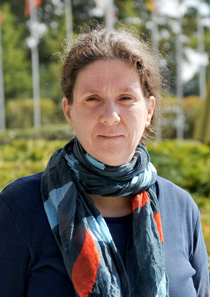
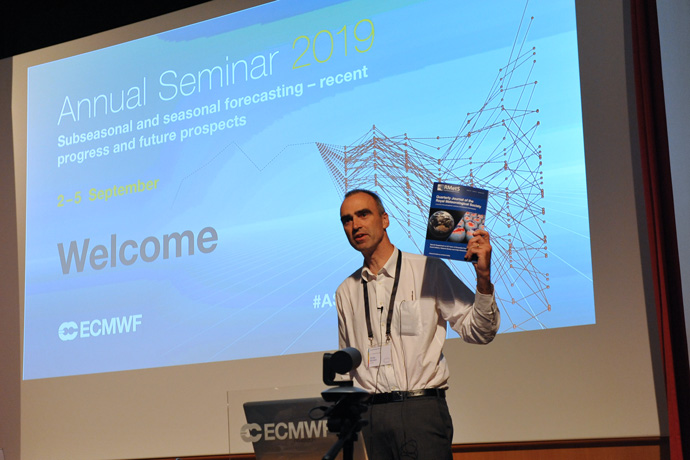
ECMWF Director of Research Andy Brown opened the ECMWF Annual Seminar 2019.
Twenty-five experts set out progress and future prospects for sub-seasonal and seasonal predictions at ECMWF’s Annual Seminar 2019 from 2 to 5 September. This flagship event in ECMWF’s calendar was attended by more than 100 participants from 22 countries.
“There were excellent talks on a broad range of topics, from the theoretical foundations of predictability at these timescales to the communication of forecast products to users,” says Magdalena Balmaseda, Head of the Earth System Predictability Section at ECMWF.
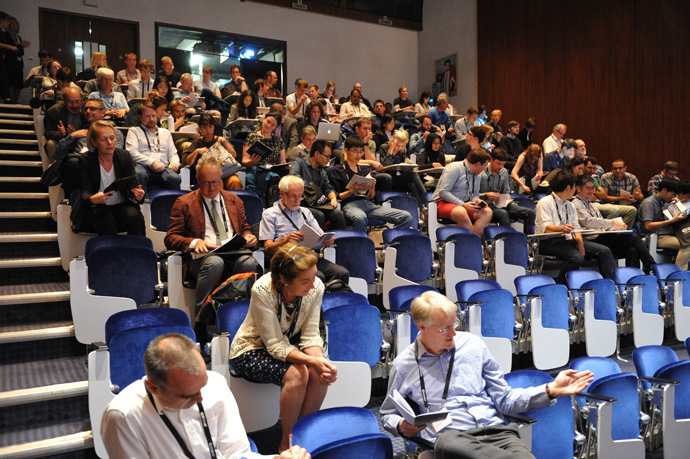
More than 100 participants from 22 countries attended the event.
Basis of predictability
In the first session, Brian Hoskins (University of Reading & Imperial College London) gave a historical overview of how our understanding of predictability beyond the medium range has developed. Ed Lorenz's view that predictions at this timescale are impossible has long given way to the realisation that different weather mechanisms have their own timescales and predictability horizons.
Roberto Buizza (Scuola Superiore Sant'Anna) noted that although we have learnt to handle the ‘butterfly effect’ of high sensitivity to initial conditions, we are still working to mitigate the ‘hawkmoth effect’, whereby the probabilistic solutions for future weather patterns can show high sensitivity to the model used.
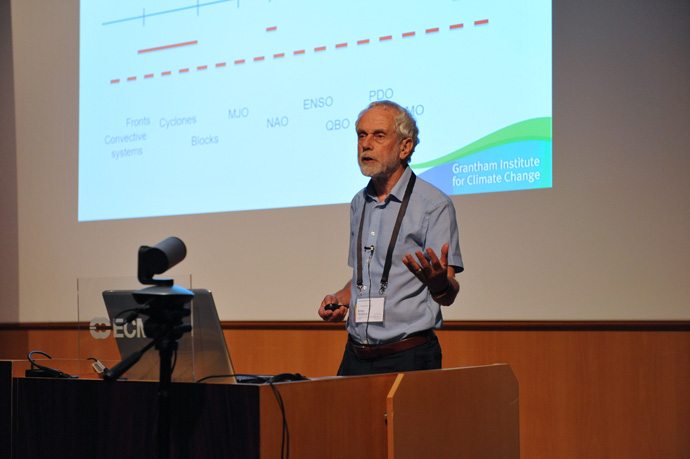
Brian Hoskins explained how our understanding of predictability has changed over time.
Franco Molteni (ECMWF) examined in more detail connections between the tropics and the mid-latitudes, demonstrating both successes and failures in the ability of our models to represent these important sources of predictability.
Physical processes
The second session was devoted to physical processes, modelling and initialisation requirements.
Magdalena Balmaseda explained that the range of skilful predictions of El Niño, marked by anomalous sea-surface temperatures in the equatorial Pacific, has been extended by over a month in the last decade.
Steven Woolnough (University of Reading) showed how the Madden-Julian Oscillation (MJO), a travelling pulse of cloud and rainfall near the equator, modulates the main tropical weather modes, such as monsoons. It also influences tropical cyclone activity and extra-tropical wave propagation.
Hisashi Nakamura (University of Tokyo) illustrated the influence of boundary currents in the extratropical ocean on local weather and climate, highlighting the impact of representing sea-surface temperature at sufficiently high resolution.

Hisashi Nakamura talked about the influence of boundary currents in the extratropical ocean.
Adam Scaife (Hadley Centre) illustrated tropical teleconnections and Rossby wave traces and highlighted the influence of the North Atlantic Oscillation (NAO) on European weather. Relatively high variability in NAO predictions across models suggests that a calibrated multi-model ensemble can enhance the usefulness of forecasts.
Emanuel Dutra (University of Lisbon) and Steffen Tietsche (ECMWF) showed that Earth surface components such as soil moisture, vegetation, snow cover and sea ice play an important role in in modulating the largest near-surface weather anomalies and are active areas of development to extend the predictability range.
Angela Benedetti (ECMWF) explained that long-lived atmospheric constituents can modify energy budgets and thus influence processes at sub-seasonal to seasonal (S2S) timescales. The role of aerosols and ozone among other constituents was highlighted. In particular, the MJO modulation of aerosol concentrations may represent an unexploited source of predictability.
Daniela Domeisen (ETH Zurich) focused on the stratosphere as a source of predictability. She showed that sudden stratospheric warming events are better predicted by models with higher vertical resolution.
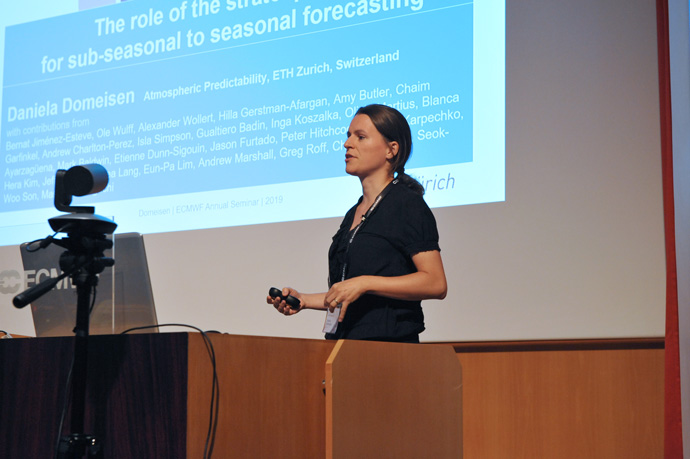
Daniela Domeisen highlighted the role of the stratosphere.
System design
The third session covered the configuration of several seasonal and sub-seasonal forecasting systems and the challenges they face.
Tim Stockdale (ECMWF) described the design of ECMWF’s seasonal forecasting system, SEAS5, and noted that inconsistencies between reanalyses and real-time analyses make assessments of improvements in forecast skill difficult.
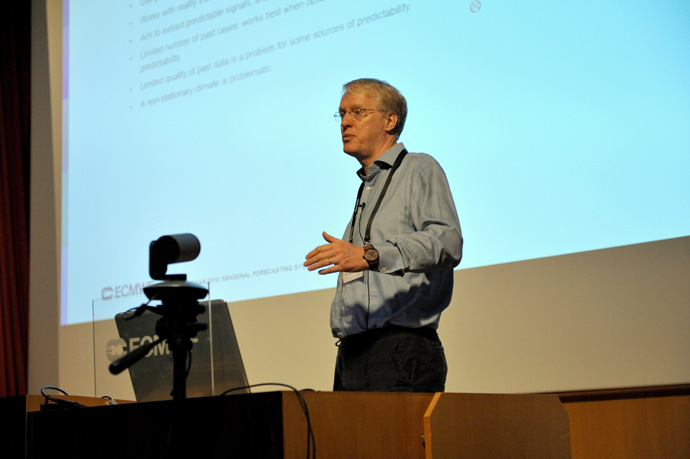
Tim Stockdale presented ECMWF’s seasonal forecasting system, SEAS5.
Oscar Alves (Australian Bureau of Meteorology, BOM) demonstrated increased skill in BOM’s latest sub-seasonal and seasonal forecasting system (ACCESS-S) and showed products for the agricultural sector that have received positive feedback.
Carolyn Reynolds (US Naval Research Laboratory) presented the US Navy's extended-range prediction system, whose high-resolution ocean model (1/12th degree) is particularly good at capturing the extension of the Gulf Stream into the North Atlantic.
Steven Pawson (NASA's Global Modeling and Assimilation Office) discussed progress achieved with NASA’s sub-seasonal forecasting system GEOS-S2S Version 2 and how NASA's missions help to guide decisions on system configuration.
Detecting and exploiting skill
David Stephenson (University of Exeter) presented statistical methods to verify probabilistic forecasts. He emphasised that sampling uncertainty is a major issue for long-range forecasts where the sample size of observations is generally small.
Johanna Baehr (University of Hamburg) presented an approach to seasonal prediction which combines output from a dynamical forecast model with information about teleconnections and physically motivated predictors to construct process-based narratives for seasonal predictions.
|
|
“We may have to rethink how we establish the credibility of our systems,” says Johanna Baehr. “Typically, we look at the signal in the ensemble mean, but in fact often the evolution of the ensemble mean does not tell a physically consistent story, or ‘narrative’. That’s because it’s a statistical measure that lacks the physical consistency of each individual ensemble member. “I’m not saying that we shouldn’t look at the ensemble mean but that there’s more to consider than the ensemble mean!” |
Tim DelSole (George Mason University/COLA) applied predictable component analysis to sub-seasonal forecasts over the US to show that temperature predictability is mostly due to persistence.
Laura Ferranti (ECMWF) discussed the predictability of high-impact weather events beyond the medium range with a special focus on the prediction of heatwaves and cold spells in Europe.
Multi-model databases
This session highlighted the vast number of studies based on multi-model data.
Frédéric Vitart (ECMWF) presented the WMO’s S2S Project and its database. Phase one of the project has addressed questions ranging from understanding the role of specific physical processes to the assessment of S2S forecasting capabilities for applications.
Kathleen Pegion (George Mason University/COLA) presented two multi-model projects: the North America Multi-model Ensemble (NMME) and the Subseasonal Experiment (SubX). She showed that predictability limit estimates are affected by very large uncertainties and should be used with caution.
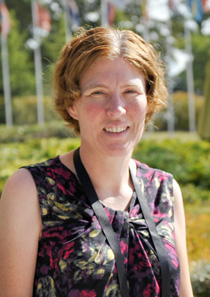 |
“Multi-model databases have great benefits both for research purposes and for operational predictions,” says Kathleen Pegion. “Multi-model ensembles are more reliable in their predictions than any single-model ensemble. We have shown that this is not just because they include more ensemble members but because each model makes a unique contribution to the prediction.” “We have demonstrated this for seasonal forecasts and we are just starting to work on similar tests for the sub-seasonal range.” |
Anca Brookshaw (ECMWF) presented the multi-model system of the EU-funded Copernicus Climate Change Service (C3S) implemented by ECMWF, including the database, graphical products and challenges related to verification and calibration.
Francisco Doblas-Reyes (Barcelona Supercomputing Center) gave an overview of the challenges associated with the development of climate information. He argued that effective communication between users and providers of the information is paramount.
Marlene Kretschmer (Postdam Institute for Climate Impact Research) showed the potential of a machine learning tool for extracting physically relevant teleconnection pathways from observations or model data.
Peter Bauer (ECMWF) closed the session and the workshop with a lecture on how the development of climate predictions could be limited by computing and data handling capabilities. He argued that investment in computing, data handling technology and artificial intelligence is needed to enable continued improvements in climate prediction systems.
Poster sessions
Poster sessions offered great opportunities for further discussions. The large variety of posters illustrated the current interest in understanding and developing seasonal and sub-seasonal forecasts.
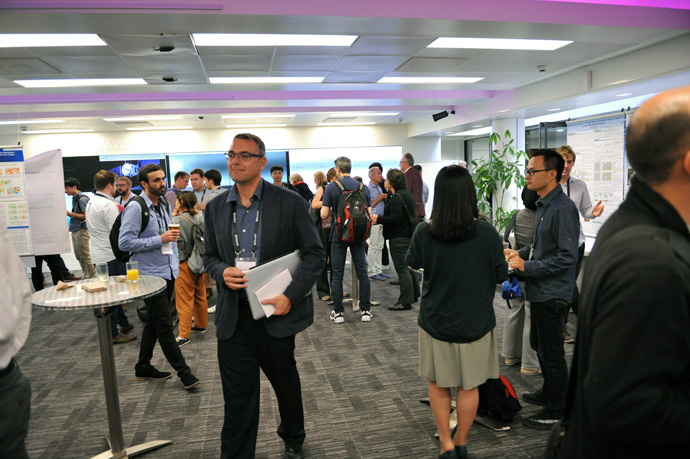
Poster sessions provided opportunities for informal exchanges at the Annual Seminar 2019.
Further information
Recordings of the talks and presentations are available on the Annual Seminar 2019 web page.

